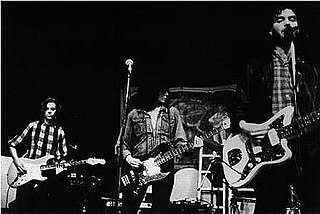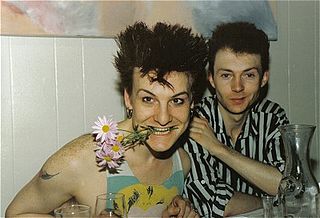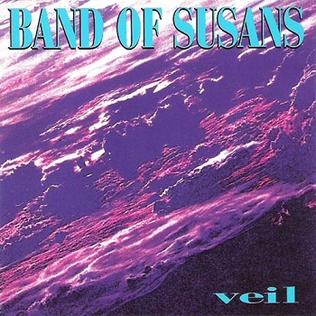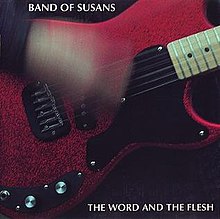No wave was an avant-garde music genre and visual art scene that emerged in the late 1970s in Downtown New York City. The term was a pun based on the rejection of commercial new wave music. Reacting against punk rock's recycling of rock and roll clichés, no wave musicians instead experimented with noise, dissonance, and atonality, as well as non-rock genres like free jazz, funk, and disco. The scene often reflected an abrasive, confrontational, and nihilistic world view.

Sonic Youth was an American rock band formed in New York City in 1981. Founding members Kim Gordon, Thurston Moore and Lee Ranaldo remained together for the entire history of the band, while Steve Shelley (drums) followed a series of short-term drummers in 1985, rounding out the core line-up. Jim O'Rourke was also a member of the band from 1999 to 2005, and Mark Ibold was a member from 2006 to 2011.

Glenn Branca was an American avant-garde composer, guitarist, and luthier. Known for his use of volume, alternative guitar tunings, repetition, droning, and the harmonic series, he was a driving force behind the genres of no wave, totalism and noise rock. Branca received a 2009 Foundation for Contemporary Arts Grants to Artists Award.

Noise rock is a noise-oriented style of experimental rock that spun off from punk rock in the 1980s. Drawing on movements such as minimalism, industrial music, and New York hardcore, artists indulge in extreme levels of distortion through the use of electric guitars and, less frequently, electronic instrumentation, either to provide percussive sounds or to contribute to the overall arrangement.

Rhys Chatham is an American composer, guitarist, trumpet player, multi-instrumentalist, primarily active in avant-garde and minimalist music. He is best known for his "guitar orchestra" compositions. He has lived in France since 1987.

Band of Susans was an American alternative rock No Wave band formed in New York City in 1986 and active until 1996. It originally consisted of Robert Poss (guitar/vocals), Susan Stenger (bass/vocals), Ron Spitzer (drums), with Susan Lyall (guitar), Susan Tallman (guitar), and Alva Rogers (vocals). The band would undergo several permutations over the years, usually involving three guitarists. Poss, Stenger, and Spitzer were the band's core members throughout its duration. They originated in the New York No Wave noise rock scene, but due to their layered guitar sound were sometimes seen as the American counterparts to the UK shoegazing bands. Like Sonic Youth, they drew influence from noise music experimental composers for the electric guitar Rhys Chatham and Glenn Branca.

No New York is a No Wave compilation album released in 1978 by record label Antilles under the curation of producer Brian Eno. Although it only contains songs by four different artists, it has been considered important in defining and documenting the scene and movement, with the name "no wave" being influenced by that of the album according to some accounts.

Pod is the debut studio album by American alternative rock band the Breeders, released by 4AD records on May 29, 1990. Engineered by Steve Albini, the album features band leader Kim Deal on vocals and guitar, Josephine Wiggs on bass, Britt Walford on drums, and Tanya Donelly on guitar. Albini's production prioritized sound over technical accomplishment; the final takes favor the band's spontaneous live "in studio" performances.
Bedhead was an American indie rock band, active from 1991 to 1998, based in Dallas, Texas. Members consisted of Matt and Bubba Kadane, Tench Coxe (guitar), Kris Wheat (bass), and Trini Martinez (drums). The band released several EPs and three LPs on Trance Syndicate, touring intermittently. Bedhead's music was generally subdued, with three electric guitars and one electric bass guitar over sung or spoken vocals. Allmusic dubbed the group "the quintessential indie rock band," and Tiny Mix Tapes gave their final album Transaction de Novo a perfect 5/5 score.

Flesh for Lulu were an English rock band formed in Brixton, London, England, active between 1982 and 1992. They reformed from 2013 to 2015 with a new lineup. Initially part of the post-punk scene, the band's sound shifted to reflect influences from pop music, country and western, rhythm and blues and blues.

Love Agenda is the second album by Band of Susans, released on April 17, 1989 by Blast First and Restless Records. Page Hamilton, later frontman for Helmet, played guitar on the album and sang the lead vocals on the track "It's Locked Away". Also notable was bassist Susan Stenger singing her first lead vocals on the songs "The Pursuit of Happiness", "Birthmark" and "Hard Light". Robert Poss was an admirer of the Rolling Stones and CD versions of Love Agenda features a cover of "Child of the Moon".

The Peel Sessions is an EP by Band of Susans, recorded in 1988 and 1989 from sessions with John Peel but not released until 1992.

Veil is the fourth studio album by American noise rock band Band of Susans. After establishing their "classic-line up" with their previous album The Word and the Flesh (1991), and recording the EP Now (1992), the band aimed for a new, more sonic and experimental direction on Veil, after the more song-centric approach to The Word and the Flesh. Recording the album in early 1993, Veil shows the band expand the margins of their sound with a more experimental approach. The album was described as "smokey" by one critic and an "epic swell of guitar and noise" by another. The album has been said to combine "R&B rhythms with crushed sonic shards," and has been compared to, and is sometimes considered to be shoegazing music.

Bear in Heaven was an American indie rock band from New York City, formed by Jon Philpot in 2003. The sound of the band incorporates influences from psychedelic music, electronic music and krautrock.

Heavy metal guitar is the use of highly-amplified electric guitar in heavy metal. Heavy metal guitar playing is rooted in the guitar playing styles developed in 1960s-era blues rock and psychedelic rock, and folk harmonic traditions and it uses a massive sound, characterized by highly amplified distortion, extended guitar solos and overall loudness. The electric guitar and the sonic power that it projects through amplification has historically been the key element in heavy metal. The heavy metal guitar sound comes from a combined use of high volumes and heavy distortion.

A rock band or pop band is a small musical ensemble that performs rock music, pop music, or a related genre. A four-piece band is the most common configuration in rock and pop music. In the early years, the configuration was typically two guitarists, a bassist, and a drummer. Another common formation is a vocalist who does not play an instrument, electric guitarist, bass guitarist, and a drummer. Sometimes, in addition to electric guitars, electric bass, and drums, also a keyboardist plays.

Here Comes Success is the fifth and final studio album by American alternative rock band Band of Susans, released on February 28, 1995, by Blast First and Restless Records.

Wired for Sound is a compilation album by Band of Susans, released in 1995 by Blast First.
Robert Poss is an American guitarist and music producer. He was the front man and primary composer for Band of Susans between 1986 and 1996. He has also collaborated with Rhys Chatham and the band When People Were Shorter and Lived Near the Water. He co-founded Trace Elements Records in 1980, which released records from artists such as Nicolas Collins and Phill Niblock.


















